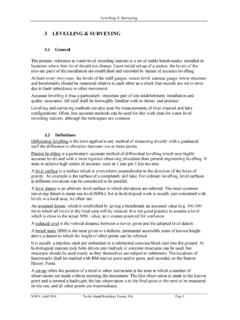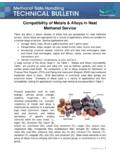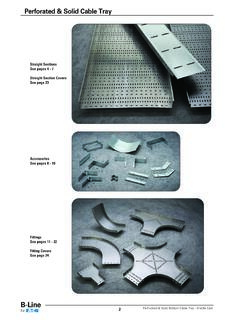Transcription of 3 LEVELLING & SURVEYING - WHYCOS Portal (@ WMO)
1 LEVELLING & SURVEYING NIWA: April 2004 Pacific Island Hydrology Course, Fiji Page 1 3 LEVELLING & SURVEYING General The primary reference at water-level recording stations is a set of stable bench-marks, installed in locations where their level should not change. Upon initial set-up of a station, the levels of the relevant parts of the installation are established and recorded by means of accurate LEVELLING . At least every two years, the levels of the staff gauges, sensor level, internal gauge, tower structure and benchmarks should be measured relative to each other as a check that records are not in error due to bank subsidence or other movement. Accurate LEVELLING is thus a particularly important part of site establishment, installation and quality assurance. All staff shall be thoroughly familiar with its theory and practice. LEVELLING and SURVEYING methods are also used for measurements of river channel and lake configurations. Often, less accurate methods can be used for this work than for water-level recording stations, although the techniques are common.
2 Definitions Differential LEVELLING is the term applied to any method of measuring directly with a graduated staff the difference in elevation between two or more points. Precise LEVELLING is a particularly accurate method of differential LEVELLING which uses highly accurate levels and with a more rigorous observing procedure than general engineering LEVELLING . It aims to achieve high orders of accuracy such as 1 mm per 1 km traverse. A level surface is a surface which is everywhere perpendicular to the direction of the force of gravity. An example is the surface of a completely still lake. For ordinary LEVELLING , level surfaces at different elevations can be considered to be parallel. A level datum is an arbitrary level surface to which elevations are referred. The most common SURVEYING datum is mean sea-level (MSL), but as hydrological work is usually just concerned with levels in a local area, we often use: An assumed datum, which is established by giving a benchmark an assumed value ( m) to which all levels in the local area will be reduced.
3 It is not good practice to assume a level which is close to the actual MSL value, as it creates potential for confusion. A reduced level is the vertical distance between a survey point and the adopted level datum. A bench mark (BM) is the term given to a definite, permanent accessible point of known height above a datum to which the height of other points can be referred. It is usually a stainless steel pin embedded in a substantial concrete block cast into the ground. At hydrological stations rock bolts driven into bedrock or concrete structures can be used, but structures should be used warily as they themselves are subject to settlement. The locations of benchmarks shall be marked with BM marker posts and/or paint, and recorded on the Station History Form. A set-up refers the position of a level or other instrument at the time in which a number of observations are made without mooring the instrument. The first observation is made to the known point and is termed a backsight; the last observation is to the final point or the next to be measured on the run, and all other points are intermediates.
4 LEVELLING & SURVEYING Page 2 Pacific Island Hydrology Course NIWA: April 2004 A run is the LEVELLING between two or more points measured in one direction only. The outward run is from known to unknown points and the return run is the check LEVELLING in the opposite direction. A close is the difference between the starting level of the initial point for the outward run and that determined at the end of the return run. If the levels have been reduced correctly this value should be the same as the difference between the sum of the rises and falls and also the difference between the sum of the backsights and foresights. Height of Collimation is the elevation of the optical axis of the telescope at the time of the setup. The line of collimation is the imaginary line at the elevation. Orders of LEVELLING refer to the quality of the LEVELLING , usually being defined by the expected maximum closing error. These are given in Table Order Purpose Maximum close (m) Precision order Deformation surveys x km First order Major LEVELLING control x km Second order Minor LEVELLING control x km Third order LEVELLING for construction x km Table 1 LEVELLING closes The accuracy requirements for water-level stations relate to the standards; for further information refer to section Change points are points of measurement which are used to carry the measurements forward in a run.
5 Each one will be read first as a foresight, the instrument position is changed, and then it will be read as a backsight. Equipment The level, its tripod, the staff and the staff bubble are all precision items of equipment upon which the accuracy of the work is highly dependent. They shall be kept correctly calibrated, and be used and stored with care. Levels shall be carried in vehicles in a padded box, case or shelf in addition to the normal case, and staves shall be kept in a canvas or plastic sleeve to prevent damage to the face and entry of dirt. Levels A level is basically a telescope attached to an accurate LEVELLING device, set upon a tripod so that it can rotate horizontally through 360 . Normally the LEVELLING device is a bubble, but modern ones incorporate a pendulum. There are three basic types of level, shown in figure (from MWD, 1981)and described below: (a) Dumpy levels LEVELLING & SURVEYING NIWA: April 2004 Pacific Island Hydrology Course, Fiji Page 3 These are more basic levels often used in construction work.
6 The telescope is rigidly attached to a single bubble and the assembly is adjusted either by means of a screwed ball-joint or by footscrews which are adjusted first in one direction, then at 90 . (b) Tilting levels This type of level is fitted with a circular bubble for preliminary approximate LEVELLING and a main bubble which is attached to the telescope. For each observation (not setup) the main bubble is viewed through an eyepiece and the telescope tilted by a fine screw to bring the two ends of the bubble into coincidence. (c) Automatic levels This more modern type of level is now in general use. It has a compensator which consists of an arrangement of three prisms. The two outer ones are attached to the barrel of the telescope. The middle prism is suspended by fine wiring and reacts to gravity. The instrument is first levelled approximately with a circular bubble; the compensator will then deviate the line of sight by the amount that the telescope is out of level. Staves The LEVELLING staff is a box section of aluminium or wood, which will extend to 3 or 5 m in height by telescoping, hinging or addition of sections.
7 One face has a graduated scale attached for reading with the cross-hairs of the level telescope. These faces can vary in pattern and graduation; 5mm graduations should be the maximum for accurate LEVELLING of gauging stations. Many staves used these days are of aluminium because of its durability. However aluminium has a co-efficient of thermal expansion of : of length/ C and this can cause some potential inaccuracies. For instance, "Survey Chief" and "Brookeades" staves are standardised at 27 C, and in very cold weather these staves could be as much as 3mm too short over their full length. For low temperature work consult the temperature table for each staff which should be with its "instruction manual" or printed on the staff itself. Staff bubbles These are generally a small circular bubble on an angle plate which is held against one corner of the staff to ensure that the staff is held in a vertical position. If the staff is not held vertical, the reading will be too large and may be significantly in error.
8 A staff bubble shall be used at all times. If one is not available, the "chainman" (staff operator) shall rock the staff slowly back and forth about the vertical in a line towards the instrument. The observer notes the smallest reading which will occur when the staff is vertical. LEVELLING & SURVEYING Page 4 Pacific Island Hydrology Course NIWA: April 2004 Figure 1 The three main types of levels. Care of equipment ensure that tripod screws and hinges are kept tight. always transport the level in a padded box. when removing from the box lift it by the centre and not by the eyepiece or objective end of the telescope. screw it firmly onto the tripod, whilst holding it in one hand (make certain that it is not cross-threaded and that threads are compatible). when carrying the level tripod assembly in the field, support it over the shoulder or, in bush, crooked over an arm with the telescope unclamped ( free to rotate). automatic levels should not be carried in a vertical or near-vertical position, as the compensator will swing about and be prone to damage.
9 LEVELLING & SURVEYING NIWA: April 2004 Pacific Island Hydrology Course, Fiji Page 5 staves are too much of a precision item of equipment to be used in place of a slasher, vaulting pole, etc. staves shall be transported in their protective cases to protect the face from damage. wooden staves which become wet should be dismantled and dried out before storing away. any moisture which is evident in an instrument must be allowed to disperse by storing the level out of its case in a warm room. Should it persist after several days the instrument may require specialist servicing. Checking the level s accuracy Levels can move out of adjustment so that their line of sight (line of collimation) is not truly horizontal. This will cause errors in readings which become greater as the viewing distance increases. However if a backsight and a foresight are exactly equi-distant from the instrument, the error in each sighting will cancel each other out. This feature can be used to check the accuracy of a level by the following simple method which is depicted in figure (from MWD, 1981): install three pegs or marks firmly in the ground at distances of 30 m apart in a straight line; the centre peg is only to mark the distance, but the outside two shall be firm enough for reliable change points set up the level over the centre peg and read the staff on each of the outside pegs in turn.
10 Book these values and calculate the height difference. This will be a true height difference, as the distances are equal and any errors will be self-compensating set up the level about 4 m to the far side of one of the outside pegs. Read the staff on the peg 4 m away and then on the one 64 m away. Book these values and calculate the apparent height difference compare the two height differences; if the instrument is in adjustment ( its collimation is true) they will be within 5 mm. Figure 2 A method for checking the level accuracy If the instrument's collimation appears to be out, recheck by repeating the process. Then, whilst setup at one of the outside locations, adjust the instrument (according to the manufacturer's LEVELLING & SURVEYING Page 6 Pacific Island Hydrology Course NIWA: April 2004 instructions) so that it reads the correct value on the far staff, checking it against the near one. Two staves are useful for this. This type of level check shall be carried out at least once per year, preferably just prior to carrying out a round of station inspections.








